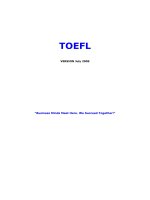sample cato bank
Bạn đang xem bản rút gọn của tài liệu. Xem và tải ngay bản đầy đủ của tài liệu tại đây (1.65 MB, 32 trang )
SAMPLE
SAMPLE PRESENTATION
PRESENTATION FOR
FOR BANK
BANK EMPLOYEES
EMPLOYEES
Corporate Account Takeover &
Information Security Awareness
The information contained in this session may contain privileged and
confidential information.
This presentation is for information purposes only. Before acting on
any ideas presented in this session; security, legal, technical, and
reputational risks should be independently evaluated considering the
unique factual circumstances surrounding each institution.
No computer system can provide absolute security under all
conditions.
Any views or opinions presented do not necessarily state or reflect
those of “Your Bank Name” or any other entity.
What will be covered?
What is Corporate Account Takeover?
How does it work?
Types of Security Threats and
Countermeasures
Current Trends
How to Protect?
How to Detect?
What to do when Fraud happens to me??
What is Corporate Account
Takeover?
A fast growing electronic crime where thieves
typically use some form of malware to obtain login
credentials to Corporate Online Banking accounts
and fraudulently transfer funds from the account(s).
Cyber threats to financial institutions and other
national critical infrastructure is real and growing at
an alarming rate.
Estimated 40,000 Chinese hacking groups
Average age ~ 2X years
Income: $2-3 Million per year
How does it work?
Criminals target victims by scams
Victim unknowingly installs software by
clicking on a link or visiting an infected Internet
site.
Fraudsters begin monitoring the accounts
Victim logs on to their Online Banking
Fraudsters Collect Login Credentials
Fraudsters wait for the right time and then
depending on your controls – they login after
hours or if you are utilizing a token they wait
until you enter your code and then they hijack
the session and send you a message that Online
Banking is temporarily unavailable.
Types of Security Threats
&
Countermeasures
Malware
Short for malicious software, is software
designed to infiltrate a computer
system
without the owner's informed consent.
Malware includes computer viruses,
worms, trojan horses, spyware,
dishonest adware, crimeware, most
rootkits, and other malicious and
unwanted software.
Viruses
A computer program that can copy itself
and infect a computer.
The term "virus" is also commonly, but
incorrectly used to refer to other types
of malware, adware, and spyware
programs that do not have the
reproductive ability.
Some viruses try to avoid detection by
killing the tasks associated with
antivirus software before it can detect
them.
Spyware
Type of malware that is installed on
computers and collects little bits of
information at a time about users without
their knowledge.
The presence of spyware is typically
hidden from the user, and can be
difficult
to detect.
It can install additional software,
redirecting Web browser, change
computer settings, different home pages,
and/or loss of Internet.
Rogue Software/Scareware
Form of malware that deceives or misleads users
into paying for the fake or simulated removal
of malware.
Has become a growing and serious security threat
in desktop computing.
Mainly relies on social engineering in order to
defeat the security software.
Most have a Trojan Horse component, which
users are misled into installing.
Browser plug-in (typically toolbar).
Image, screensaver or ZIP file attached to an e-mail.
Multimedia codec required to play a video clip.
Software shared on peer-to-peer networks
A free online malware scanning service
Phishing
Criminally fraudulent process of
attempting to acquire sensitive information
(usernames, passwords, credit card
details) by masquerading as a trustworthy
entity in an electronic communication.
Commonly used means:
Social web sites
Auction sites
Online payment processors
IT administrators
E-mail Usage
Some experts feel e-mail is the biggest
security threat of all.
The fastest, most-effective method of
spreading malicious code to the
largest
number of users.
Also a large source of wasted
technology resources
Examples of corporate e-mail waste:
Electronic Greeting Cards
Chain Letters
Jokes and graphics
Spam and junk e-mail
Hoaxes
Hoaxes attempt to trick or defraud users.
A hoax could be malicious, instructing
users to delete a file necessary to the
operating system by claiming it is a virus.
It could also be a scam that convinces
users to send money or personal
information.
Phishing attacks fall into this category
Statistics
Where does it come from?
Malicious websites (including Social
Networking sites)
P2P Downloads (e.g. LimeWire)
Ads from popular web sites
Web-borne infections:
According to researchers in the first quarter of 2011,
76% of web resources used to spread malicious
programs were found in 5 countries worldwide ~
United States, Russian Federation, Netherlands,
China, & Ukraine.
What your Bank can do!
PROTECT
Know your Customers - Develop a Risk Assessment:
Determine which customers are high-risk
Types of transactions – wires, bank to bank, SEC Code,
daily files, high limits/frequencies, financial stability
Provide Ongoing Security Awareness Training for BOTH Employees &
Corporate Customers
TRAIN! TRAIN! TRAIN!
Make sure that your Customers are Aware of Basic Online
Security Practices
Review your Contracts
Make sure that you clearly state roles & responsibilities of
both parties and dispute resolution processes
Stay Informed
Attend webinars/seminars & other user group meetings
Develop a layered security approach
Perform a Due Diligence review of any third-party service providers for
Online Banking Services
What your Bank can do!
DETECT
Detection is closely associated with protection because some
measures that protect also help identify fraud.
Layered Security
It has already been proven that a single layer is easy for
hackers to get through. If one layer develops a security
weakness then hopefully the other layers will provide
sufficient protection.
Monitoring of IP Addresses
New User Controls
Calendar File – Frequencies and Limits
Dual Control
Fax or Out of Band Confirmation
Secure Brower or Secure Browser Key
Pattern Recognition Software
Train Bank employees on Fraud warning signs









